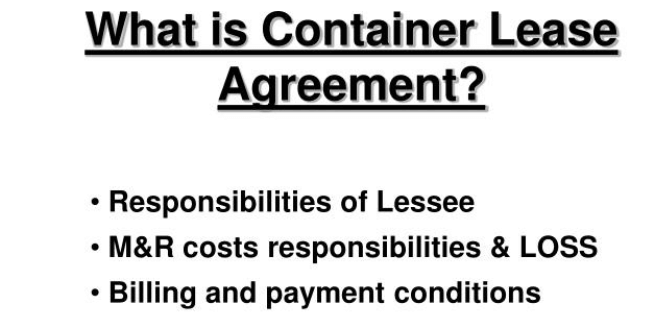Different types of Container Leasing Agreements – Find details.
| Click on "Load tracking box" -> Wait for tracking page to load -> Enter order Number and track - > Now click Close |
|---|
Before contacting a container leasing company, you need to know what type of leasing contract you are looking for.

Regardless of the rental agreement, there are standard obligations that must be fulfilled. One of these obligations is basically to return the “borrowed” box in the same condition (more or less) as it was received. Leasing companies usually cover some wear, such as replacing stickers.
All rental agreements are different. In other words, because it depends on many factors, the conditions are also strict. Now let’s take a quick look at the basic types of rental contracts.
| Agreement | Duration | Maintenance and Repair | Drop-off Location |
| Master Lease | variable | Leasing Company | restrictive |
| Long-Term Lease | 5-8 years | Lessee | super restrictive |
| Short-Term Lease | greater than 6 months | Lessee | super restrictive |
| One-way lease | variable | Lessee | shipper’s desire |
Table of Contents
Various Container Leasing Agreements
Master lease Agreements
Master lease contracts are the most flexible. But of course, it comes at a higher price. Some perks include a long list of pickup and drop-off locations, from which you can combine and combine. You can save storage fees by storing the container in the lender’s warehouse. Drop-offs in unauthorized locations are still subject to heavy fines, but with far more options.
These fines are flexible under a master lease, as opposed to container quantities and rental fees. Therefore, container demand forecasts do not necessarily have to be accurate. Carriers with very large fleets and unpredictable demand usually enter into this type of leasing contract. The additional benefit of higher costs is that the leasing company bears the burden of repair, maintenance, and relocation.
Long-term lease Agreements
Much less flexible than master leases are long-term leases. Popular among leasing companies. Here, a contract for a certain period of time is agreed. So is the pre-determined amount of containers and delivery schedules. A contract that does almost nothing to the leasing company once the container is signed.
The lessee bears the cost of repairs, maintenance, and relocation. There are various definitions of terms, but most leasing companies define long-term leases as 5 to 8 years. Containers are usually new and many long-term lease agreements have negotiable provisions. This clause allows you to negotiate rents in the next few years, taking into account depreciation and market volatility.
Lease buyout
You can relate this to the concept of “rental”. There are various options for this. One method is a standard rental fee and a final balloon payment. The other is a higher rental fee, which incurs the final purchase price.
Not surprisingly, the total amount spent on this option is higher than buying a container. But that’s an option you might take when you don’t have cash on hand. Another drawback is that if you do not pay within the time period, you may lose your right to purchase the container. For small businesses, operations, and projects, this lease may not be ideal.
Short-term lease Agreements
Short-term container leases are usually charged at higher rental rates. Just like hiring a car, it’s perfect for turnaround trips. One setback here is the minimum amount of time that must be adhered to in order to use the container, except that it is expensive. In many cases, leasing companies do not want to lease containers for less than 6 months.
One-way lease Agreements
At the beginning of this blog post, I briefly explained about one-way leasing. With one-way leasing, the container user leases the shipping container in that one trip. that’s it.
In this type of lease, we discuss the collection fee. They depend on the availability of containers at your location. Another is a free day. Holidays determine how long you can use the container for free before paying your daily allowance. When leasing in one direction, you usually pay very little per diem and have more free days.
Leasing companies such as Triton and Seaco offer one-way leasing with over 600 other leasing and shipping companies are available to lease containers.
